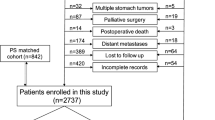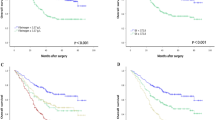Abstract
Background
Improved prediction of prognosis for gastrointestinal stromal tumours (GISTs) has become increasingly important since the introduction of targeted therapy. Here, we aimed to evaluate the prognostic significance of preoperative plasma fibrinogen (Fib) levels in patients with primary GISTs and to analyse their correlations with clinicopathological characteristics.
Methods
A total of 201 previously untreated patients with primary GISTs who had undergone radical surgery at our institution between October 2004 and July 2018 were enrolled. The optimal cut-off value for Fib levels was calculated using time-dependent receiver-operating characteristic curve analysis. RFS, the primary endpoint, was calculated by the Kaplan–Meier method and compared by the log-rank test. Univariate and multivariate Cox regression models were calculated.
Results
High preoperative plasma Fib levels were detected as an independent adverse prognostic factor (p = 0.008, hazard ratio 3.136, 95% CI 1.356‒7.256). Furthermore, high preoperative plasma Fib levels also indicated a poor prognosis within the modified National Institutes of Health (mNIH) high-risk subgroup (p = 0.041). In addition, preoperative plasma Fib levels showed a positive correlation with several prognostic factors and even a linear relationship with tumour size (Spearman correlation coefficient [r] = 0.411, p < 0.001).
Conclusions
Our results suggest that high preoperative plasma Fib levels may indicate a poor prognosis in patients with primary GISTs. As a cost-effective biomarker, preoperative assessment of plasma Fib levels may help to further risk stratify patients with mNIH high-risk GISTs and instruct the application of targeted therapy.




Similar content being viewed by others
References
Miettinen M, Lasota J (2011) Histopathology of gastrointestinal stromal tumor. J Surg Oncol 104(8):865–873
Gatta G, van der Zwan JM, Casali PG et al (2011) Rare cancers are not so rare: the rare cancer burden in Europe. Eur J Cancer 47(17):2493–2511
von Mehren M, Joensuu H (2018) Gastrointestinal stromal tumors. J Clin Oncol 36(2):136–143
von Mehren M, Randall RL, Benjamin RS et al (2018) Soft tissue sarcoma, version 2.2018, NCCN Clinical Practice Guidelines in Oncology. J Natl Compr Canc Netw 16(5):536–563
Dematteo RP, Ballman KV, Antonescu CR et al (2009) Adjuvant imatinib mesylate after resection of localised, primary gastrointestinal stromal tumour: a randomised, double-blind, placebo-controlled trial. Lancet 373(9669):1097–1104
Casali PG, Zalcberg J, Le Cesne A et al (2017) Ten-year progression-free and overall survival in patients with unresectable or metastatic GI stromal tumors: long-term analysis of the european organisation for research and treatment of cancer, Italian Sarcoma Group, and Australasian Gastrointestinal Trials Group intergroup phase III randomized trial on imatinib at two dose levels. J Clin Oncol 35(15):1713–1720
Joensuu H (2008) Risk stratification of patients diagnosed with gastrointestinal stromal tumor. Hum Pathol 39(10):1411–1419
Miettinen M, Lasota J (2006) Gastrointestinal stromal tumors: pathology and prognosis at different sites. Semin Diagn Pathol 23(2):70–83
Fletcher CD, Berman JJ, Corless C et al (2002) Diagnosis of gastrointestinal stromal tumors: a consensus approach. Hum Pathol 33(5):459–465
Gold JS, Gonen M, Gutierrez A et al (2009) Development and validation of a prognostic nomogram for recurrence-free survival after complete surgical resection of localised primary gastrointestinal stromal tumour: a retrospective analysis. Lancet Oncol 10(11):1045–1052
Joensuu H, Vehtari A, Riihimaki J et al (2012) Risk of recurrence of gastrointestinal stromal tumour after surgery: an analysis of pooled population-based cohorts. Lancet Oncol 13(3):265–274
Repetto O, De Re V (2017) Coagulation and fibrinolysis in gastric cancer. Ann N Y Acad Sci 1404(1):27–48
Palumbo JS (2008) Mechanisms linking tumor cell-associated procoagulant function to tumor dissemination. Semin Thromb Hemost 34(2):154–160
Tennent GA, Brennan SO, Stangou AJ et al (2007) Human plasma fibrinogen is synthesized in the liver. Blood 109(5):1971–1974
Huang G, Jiang H, Lin Y et al (2018) Prognostic value of plasma fibrinogen in hepatocellular carcinoma: a meta-analysis. Cancer Manag Res 10:5027–5041
Matsuda S, Takeuchi H, Kawakubo H et al (2015) Cumulative prognostic scores based on plasma fibrinogen and serum albumin levels in esophageal cancer patients treated with transthoracic esophagectomy: comparison with the Glasgow prognostic score. Ann Surg Oncol 22(1):302–310
Yu X, Hu F, Yao Q et al (2016) Serum fibrinogen levels are positively correlated with advanced tumor stage and poor survival in patients with gastric cancer undergoing gastrectomy: a large cohort retrospective study. BMC Cancer 16:480
Lee JH, Hyun JH, Kim DY et al (2015) The role of fibrinogen as a predictor in preoperative chemoradiation for rectal cancer. Ann Surg Oncol 22(1):209–215
Qi Q, Geng Y, Sun M et al (2015) Hyperfibrinogen is associated with the systemic inflammatory response and predicts poor prognosis in advanced pancreatic cancer. Pancreas 44(6):977–982
Lu J, Chen S, Li X et al (2018) Gastrointestinal stromal tumors: fibrinogen levels are associated with prognosis of patients as blood-based biomarker. Medicine (Baltimore) 97(17):e0568
Cai HX, Li XQ, Wang SF (2018) Prognostic value of fibrinogen and d-dimer-fibrinogen ratio in resectable gastrointestinal stromal tumors. World J Gastroenterol 24(44):5046–5056
Rubin BP, Blanke CD, Demetri GD et al (2010) Protocol for the examination of specimens from patients with gastrointestinal stromal tumor. Arch Pathol Lab Med 134(2):165–170
Palumbo JS, Kombrinck KW, Drew AF et al (2000) Fibrinogen is an important determinant of the metastatic potential of circulating tumor cells. Blood 96(10):3302–3309
Palumbo JS, Potter JM, Kaplan LS et al (2002) Spontaneous hematogenous and lymphatic metastasis, but not primary tumor growth or angiogenesis, is diminished in fibrinogen-deficient mice. Cancer Res 62(23):6966–6972
Ludwig RJ, Alban S, Bistrian R et al (2006) The ability of different forms of heparins to suppress P-selectin function in vitro correlates to their inhibitory capacity on bloodborne metastasis in vivo. Thromb Haemost 95(3):535–540
Stevenson JL, Choi SH, Varki A (2005) Differential metastasis inhibition by clinically relevant levels of heparins–correlation with selectin inhibition, not antithrombotic activity. Clin Cancer Res 11(19 Pt 1):7003–7011
Roxburgh CS, Salmond JM, Horgan PG et al (2009) Comparison of the prognostic value of inflammation-based pathologic and biochemical criteria in patients undergoing potentially curative resection for colorectal cancer. Ann Surg 249(5):788–793
Proctor MJ, Morrison DS, Talwar D et al (2011) A comparison of inflammation-based prognostic scores in patients with cancer. A Glasgow Inflammation Outcome Study. Eur J Cancer 47(17):2633–2641
Arigami T, Uenosono Y, Ishigami S et al (2016) Clinical significance of the glasgow prognostic score in patients with gastrointestinal stromal tumors. Anticancer Res 36(12):6687–6690
Falanga A, Marchetti M, Vignoli A (2013) Coagulation and cancer: biological and clinical aspects. J Thromb Haemost 11(2):223–233
Falanga A, Schieppati F, Russo D (2015) Cancer tissue procoagulant mechanisms and the hypercoagulable state of patients with cancer. Semin Thromb Hemost 41(7):756–764
Racz JM, Cleghorn MC, Jimenez MC et al (2015) Predictive ability of blood neutrophil-to-lymphocyte and platelet-to-lymphocyte ratios in gastrointestinal stromal tumors. Ann Surg Oncol 22(7):2343–2350
Zhao L, Feng S, Huang S et al (2017) Diagnostic value of hyperfibrinogenemia as a predictive factor for appendiceal perforation in acute appendicitis. ANZ J Surg 87(5):372–375
Degen JL, Palumbo JS (2003) Mechanisms linking hemostatic factors to tumor growth in mice. Pathophysiol Haemost Thromb 33(Suppl 1):31–35
Staton CA, Brown NJ, Lewis CE (2003) The role of fibrinogen and related fragments in tumour angiogenesis and metastasis. Expert Opin Biol Ther 3(7):1105–1120
Neufert C, Becker C, Neurath MF (2007) An inducible mouse model of colon carcinogenesis for the analysis of sporadic and inflammation-driven tumor progression. Nat Protoc 2(8):1998–2004
Steinbrecher KA, Harmel-Laws E, Sitcheran R et al (2008) Loss of epithelial RelA results in deregulated intestinal proliferative/apoptotic homeostasis and susceptibility to inflammation. J Immunol 180(4):2588–2599
Palumbo JS, Talmage KE, Liu H et al (2003) Plasminogen supports tumor growth through a fibrinogen-dependent mechanism linked to vascular patency. Blood 102(8):2819–2827
Steinbrecher KA, Horowitz NA, Blevins EA et al (2010) Colitis-associated cancer is dependent on the interplay between the hemostatic and inflammatory systems and supported by integrin alpha(M)beta(2) engagement of fibrinogen. Cancer Res 70(7):2634–2643
Simpson-Haidaris PJ, Rybarczyk B (2001) Tumors and fibrinogen. The role of fibrinogen as an extracellular matrix protein. Ann N Y Acad Sci 936:406–425
Acknowledgements
The authors are grateful to all medical staff of the Department of General Surgery, Beijing Hospital, for their contributions to follow-up and data collection.
Funding
Not applicable.
Author information
Authors and Affiliations
Contributions
SBS designed the study, analysed the data, and wrote the manuscript. GX assisted in the study design, data interpretation, and revision. XLC, HDP, JHS, and GZ contributed to the study design and revision. MLH, QXY and HY contributed to the data collection and analysis. All authors read and approved the final manuscript. All authors read and approved the final manuscript.
Corresponding author
Ethics declarations
Conflict of interest
The authors declare that they have no competing interests.
Ethics approval and consent to participate
The study was approved by the Ethics Committee of Beijing Hospital with Approval Letter No. 2019BJYYEC-030-01 and was granted an exemption from requiring informed consent.
Data transparency
The datasets used and/or analysed during the current study are available from the corresponding author on reasonable request.
Additional information
Publisher's Note
Springer Nature remains neutral with regard to jurisdictional claims in published maps and institutional affiliations.
About this article
Cite this article
Song, S., Cao, X., Pan, H. et al. Prognostic significance of preoperative plasma fibrinogen levels in primary gastrointestinal stromal tumours: a retrospective cohort study. Int J Clin Oncol 25, 1506–1514 (2020). https://doi.org/10.1007/s10147-020-01689-8
Received:
Accepted:
Published:
Issue Date:
DOI: https://doi.org/10.1007/s10147-020-01689-8




